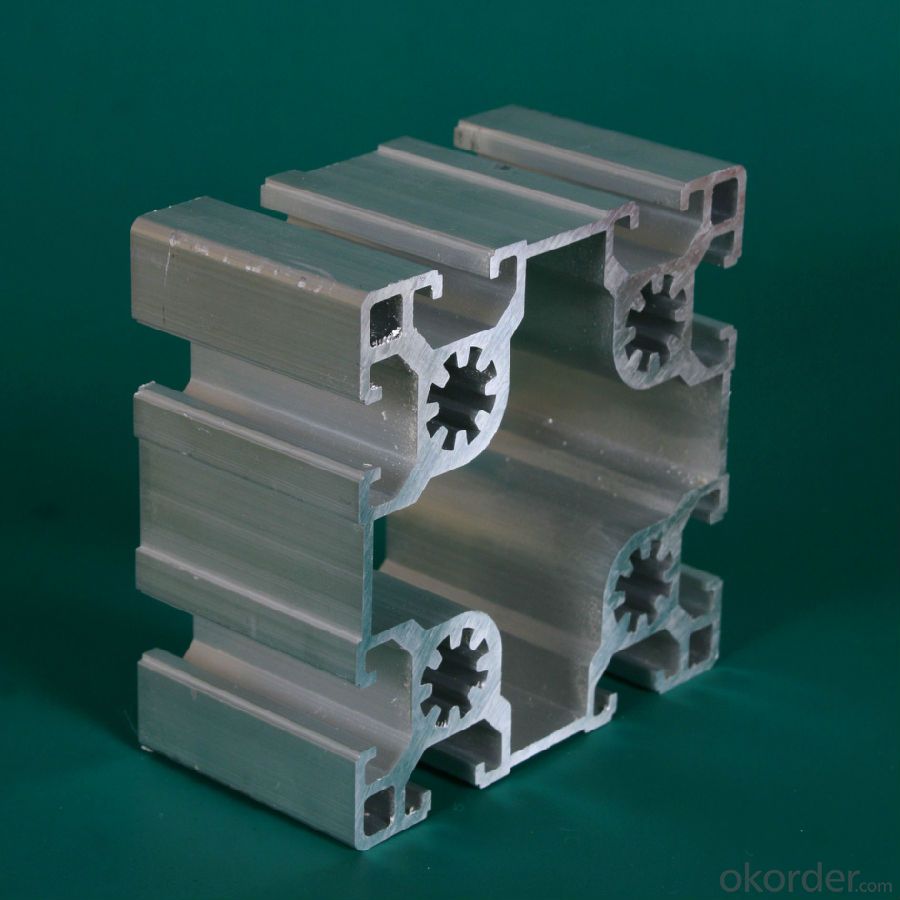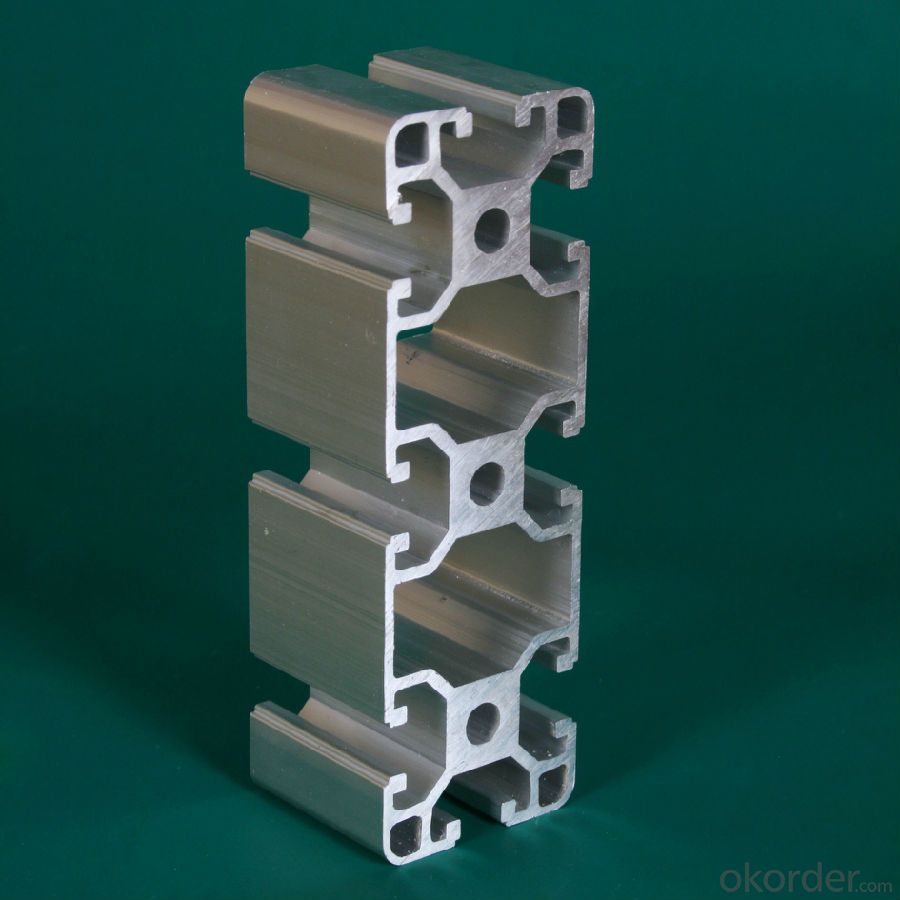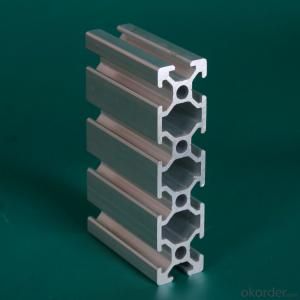Alloy 7075 Aluminium Extrusion Profiles For Industrial Application
- Loading Port:
- Qingdao
- Payment Terms:
- TT OR LC
- Min Order Qty:
- 2 m.t.
- Supply Capability:
- 50000 m.t./month
OKorder Service Pledge
OKorder Financial Service
You Might Also Like
Item specifice
Product Description
Product Name | Alloy 7075 Aluminium Extrusion Profiles For Industrial Application |
Alloy | Al 6063 T5 /T6 or 6061 T4/T6 or as customers' need |
Surface | Aluminum profiles of mill finish, powder coating, anodizing, polishing, sand blasting, electrophoresis and wood color. |
Profile shape | According to drawings or re-design as requested or market needs. |
Price | Based on Aluminum Ingot Price + Process fee |
Payment term | T/C T/T 30% deposit and 70% pay against copy of B/L |
Certificate | ISO9001 ISO14001 |
Warranty | 1. GB5237-2008 equal to EN12020-1.2(2001); 2. Within 15 years without powder peeling off; |


Product Advantages
1. Plenty of surface treatments for your choice, for example oxidation, electrophoresis and static powder coating, etc.
2. Strict control for surface finish, very little scratch.
3. Accurate mold as well as accurate size.
4. Standard alloy composition
5. Both ends of the profiles are very plain and with no burr.
FAQ
1. What is your main product?
We can supply the aluminium complete system, including aluminum billets, aluminum profile for windows and doors, aluminum for curtain wall, alumimun framwork, and kinds of aluminum windows and doors.
2. What’s your price?
The price is based on buyer's specific requirement, so please provide below information to help us quote exact price to you.
3. What is your payment term?
30% - 50% down payment, the balance payment against, and L/C is available.
- Q:Calculation of heat dissipation of aluminium profile radiator
- This requires software that is not easy to compute directly, and the formulas may pull out a long string and are inaccurateBecause the contact of the bottom of the profile is initiated by the heat source, the contact area is first set, which affects the distance and conduction angle of the thermal conductivityWhen you change this condition, the whole formula varies greatlyAgain, set convection and convection intensities, convection fluid properties and relative heat exchange efficienciesIn the radiator industry, there have been similar formulas, but only the natural convection settings, and in the heat under the state, heat dissipation at room temperature settingsProfessional software has many, FLOWTHEM, e-therm, ice-pake and so on, even Pro-E seems to be able to hang modules to do simulationSuggest going directly to software
- Q:Who would like to know, aluminum radiator mainly used in which instruments or equipment, trouble to say more detailed points, thank you
- Large, such as ZTE, HUAWEI communications control center, as well as the main table server, large cabinet
- Q:How is the aluminum alloy profile series divided?
- According to alloy composition.1 pure aluminum, such as 1100,2 series aluminum alloy3 Series al Mn alloys, such as 3003, 3A214 series Al Si alloy5 Series Al Mg alloy6 series Al Mg Si alloy, such as 606360617 Series Al Zn Alloy8 lines, others9 line standby
- Q:Which aluminum profile is better here in Guangdong?
- 1 、 aluminum material2, Zhong Wang aluminum3 Asia Aluminum4, Hing Fat aluminum5, the phoenix aluminum aluminum6, the United States and aluminum7, vibration or aluminum8 、 Nanshan aluminum material9, pillars of aluminum10, South South aluminum
- Q:How are the tonnage grades of aluminum extrusion machines classified?
- Aluminum material is soft, so it is easy to produce the top injury, pressure injury, scratch and deformation in the stamping production. Besides the requirements on the die, the following points should be done in the stamping process:1, to make aluminum stamping, reducing non-performing rate, the first to do 5S, especially clean, including mold, punch table, pipeline and packaging materials must be no sharp debris, no dirt regularly clear rectification, the upper and lower mold must be clean without debris.2, found that product burr larger, must promptly send mold maintenance, and follow the results.3, aluminum parts easier to heat, and the backlog of hard together, so in the blanking, when the material needs to be coated with a little pressure on the oil (to heat dissipation, but also smooth to clear the material), and then stamping.4, punching more products need to do blow cleaning the mold surface, do product mould, keep clean, reduce top injury, injury must be found on top of the mold top point to find out and solve the injury problems to continue production.5, push the flat mold block will produce aluminum chip, so push block production every day, must be washed under the push block aluminum scrap.Our company with advanced production equipment and technology, relying on a strong technical team, and has established a perfect quality management system, ensure the reliable quality of products, products with first-class quality, reasonable price, sold in the city and region, sales performance is good, whether we are in a peer or in the guest account, have a high reputation.
- Q:What are the different extrusion processes used for aluminum profiles?
- There are several different extrusion processes used for aluminum profiles, each with its own unique advantages and applications. Some of the most common extrusion processes used for aluminum profiles include: 1. Direct extrusion: This is the most common and widely used extrusion process for aluminum profiles. In direct extrusion, a heated aluminum billet is forced through a die to create the desired shape. This process is efficient, cost-effective, and suitable for producing simple to complex profiles with consistent cross-sections. 2. Indirect extrusion: In this process, the billet is held stationary while the die moves, pushing the aluminum through the die to form the profile. Indirect extrusion is often preferred for producing profiles with intricate internal features or when higher surface finish and tighter tolerances are required. 3. Impact extrusion: Impact extrusion is a specialized process used to create hollow aluminum profiles, such as tubes or containers. In this process, a slug of aluminum is placed in a die and a punch is driven into the slug, causing it to flow around the punch and form the desired shape. Impact extrusion is particularly suitable for producing thin-walled profiles with complex shapes. 4. Hydrostatic extrusion: Hydrostatic extrusion is a cold extrusion process that involves forcing the aluminum billet through a die using a high-pressure liquid. This process is often used for producing high-strength aluminum profiles with improved mechanical properties and dimensional accuracy. 5. Hot extrusion: In hot extrusion, the aluminum billet is heated to a temperature above its recrystallization point and then forced through a die. This process is typically used for producing profiles with complex shapes, as the high temperature allows for better material flow and deformation. Each extrusion process offers its own benefits and is chosen depending on the specific requirements of the aluminum profile being produced. Factors such as the desired shape, complexity, surface finish, tolerances, and mechanical properties play a significant role in determining the most suitable extrusion process for aluminum profiles.
- Q:What are the different extrusion methods used for aluminum profiles?
- There are several different extrusion methods used for aluminum profiles, including direct extrusion, indirect extrusion, impact extrusion, and hydrostatic extrusion. Each method has its own advantages and is suited for specific applications. Direct extrusion involves pushing the aluminum billet through a die to create the desired shape, while indirect extrusion involves the billet being held stationary and the die moving towards it. Impact extrusion involves forcing the aluminum into a die cavity using a high-velocity impact, and hydrostatic extrusion uses high-pressure fluid to push the aluminum through the die.
- Q:What is the difference between aluminum alloy and 6063-T5 6060-T66?
- 6060-T66, higher strength, average mechanical performance is higher than T6 under 20-30Mpa condition [T66 is in T6 (solid solution strengthening + fully artificial aging) condition, strengthened by special process status - in European standard can be found] 6063-T5 is the most common aluminum alloy and delivery condition, and most of the architectural profiles are applied
- Q:What are the advantages of using aluminum profiles in the oil and gas industry?
- There are several advantages of using aluminum profiles in the oil and gas industry. Firstly, aluminum profiles offer exceptional strength-to-weight ratio. This means that they provide high structural integrity while being lightweight, which is crucial in industries like oil and gas where equipment needs to be transported and installed in various locations. The lightweight nature of aluminum profiles also reduces the load on structures and equipment, resulting in energy savings and improved efficiency. Secondly, aluminum profiles are highly corrosion-resistant. The oil and gas industry often operates in harsh environments, including exposure to saltwater, chemicals, and extreme temperatures. Aluminum's natural oxide layer acts as a protective barrier, preventing corrosion and ensuring durability in these challenging conditions. This resistance to corrosion significantly reduces maintenance and replacement costs over the lifespan of the equipment. Additionally, aluminum profiles are non-magnetic, making them suitable for applications where magnetic interference is a concern. In the oil and gas industry, where precision and accuracy are crucial, the non-magnetic nature of aluminum profiles ensures that equipment operates without any electromagnetic interference, ensuring data accuracy and reliable performance. Furthermore, aluminum profiles can be easily fabricated and customized to meet specific requirements. They can be extruded into various shapes, sizes, and configurations, allowing for endless design possibilities. This flexibility in manufacturing makes aluminum profiles highly versatile, enabling them to be used in a wide range of applications within the oil and gas industry, including pipe racks, platforms, support structures, and access systems. Lastly, aluminum is a sustainable and environmentally friendly material. It is 100% recyclable without losing its properties, making it a sustainable choice for the oil and gas industry that increasingly focuses on reducing its carbon footprint. Aluminum's recyclability also contributes to cost savings and resource conservation. In summary, the advantages of using aluminum profiles in the oil and gas industry include their high strength-to-weight ratio, corrosion resistance, non-magnetic properties, easy fabrication, and recyclability. These characteristics make aluminum profiles a reliable and cost-effective solution for various applications in this industry.
- Q:Tips for identifying aluminum profiles
- First of all, to see whether the aluminum profile has obvious distortion, the surface is smooth and smooth, there is no crack or boldness of vision, scratches, burrs, and if found, some super good, do not buy.Secondly, it is necessary to carefully check the color of aluminum surface, whether there are different shades of color, there is color difference, that is, the quality is not pass.
1. Manufacturer Overview |
|
|---|---|
| Location | |
| Year Established | |
| Annual Output Value | |
| Main Markets | |
| Company Certifications | |
2. Manufacturer Certificates |
|
|---|---|
| a) Certification Name | |
| Range | |
| Reference | |
| Validity Period | |
3. Manufacturer Capability |
|
|---|---|
| a)Trade Capacity | |
| Nearest Port | |
| Export Percentage | |
| No.of Employees in Trade Department | |
| Language Spoken: | |
| b)Factory Information | |
| Factory Size: | |
| No. of Production Lines | |
| Contract Manufacturing | |
| Product Price Range | |
Send your message to us
Alloy 7075 Aluminium Extrusion Profiles For Industrial Application
- Loading Port:
- Qingdao
- Payment Terms:
- TT OR LC
- Min Order Qty:
- 2 m.t.
- Supply Capability:
- 50000 m.t./month
OKorder Service Pledge
OKorder Financial Service
Similar products
New products
Hot products
Related keywords






























